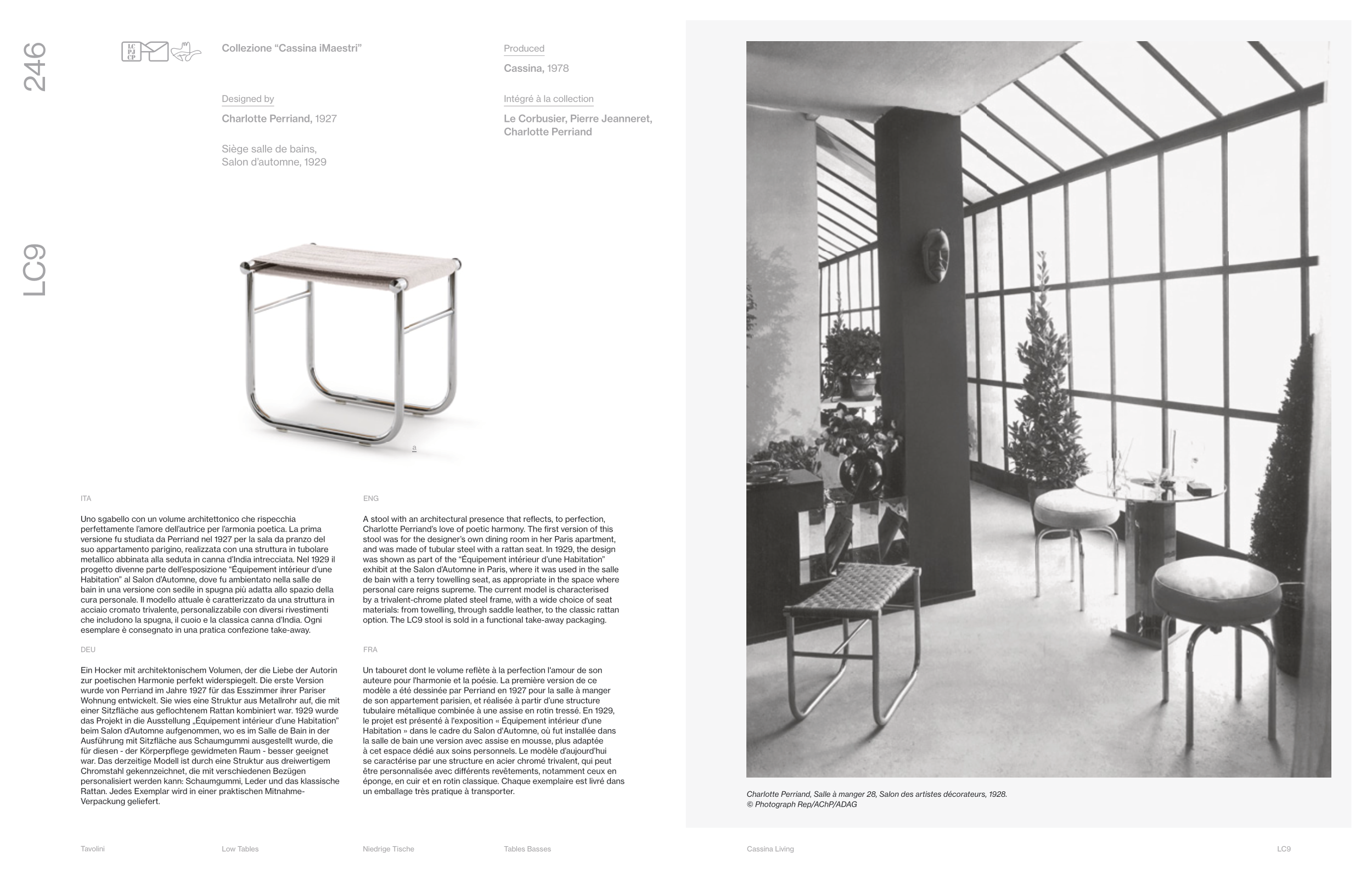Uno sgabello con un volume architettonico che rispecchia
perfettamente l’amore dell’autrice per l’armonia poetica. La prima
versione fu studiata da Perriand nel 1927 per la sala da pranzo del
suo appartamento parigino, realizzata con una struttura in tubolare
metallico abbinata alla seduta in canna d’India intrecciata. Nel 1929 il
progetto divenne parte dell’esposizione “Équipement intérieur d’une
Habitation” al Salon d’Automne, dove fu ambientato nella salle de
bain in una versione con sedile in spugna più adatta allo spazio della
cura personale. Il modello attuale è caratterizzato da una struttura in
acciaio cromato trivalente, personalizzabile con diversi rivestimenti
che includono la spugna, il cuoio e la classica canna d’India. Ogni
esemplare è consegnato in una pratica confezione take-away.
Ein Hocker mit architektonischem Volumen, der die Liebe der Autorin
zur poetischen Harmonie perfekt widerspiegelt. Die erste Version
wurde von Perriand im Jahre 1927 für das Esszimmer ihrer Pariser
Wohnung entwickelt. Sie wies eine Struktur aus Metallrohr auf, die mit
einer Sitzfl äche aus gefl ochtenem Rattan kombiniert war. 1929 wurde
das Projekt in die Ausstellung „Équipement intérieur d’une Habitation”
beim Salon d’Automne aufgenommen, wo es im Salle de Bain in der
Ausführung mit Sitzfl äche aus Schaumgummi ausgestellt wurde, die
für diesen - der Körperpfl ege gewidmeten Raum - besser geeignet
war. Das derzeitige Modell ist durch eine Struktur aus dreiwertigem
Chromstahl gekennzeichnet, die mit verschiedenen Bezügen
personalisiert werden kann: Schaumgummi, Leder und das klassische
Rattan. Jedes Exemplar wird in einer praktischen Mitnahme-
Verpackung geliefert.
A stool with an architectural presence that refl ects, to perfection,
Charlotte Perriand’s love of poetic harmony. The fi rst version of this
stool was for the designer’s own dining room in her Paris apartment,
and was made of tubular steel with a rattan seat. In 1929, the design
was shown as part of the “Équipement intérieur d’une Habitation”
exhibit at the Salon d’Automne in Paris, where it was used in the salle
de bain with a terry towelling seat, as appropriate in the space where
personal care reigns supreme. The current model is characterised
by a trivalent-chrome plated steel frame, with a wide choice of seat
materials: from towelling, through saddle leather, to the classic rattan
option. The LC9 stool is sold in a functional take-away packaging.
Un tabouret dont le volume refl ète à la perfection l'amour de son
auteure pour l'harmonie et la poésie. La première version de ce
modèle a été dessinée par Perriand en 1927 pour la salle à manger
de son appartement parisien, et réalisée à partir d’une structure
tubulaire métallique combinée à une assise en rotin tressé. En 1929,
le projet est présenté à l'exposition « Équipement intérieur d'une
Habitation » dans le cadre du Salon d'Automne, où fut installée dans
la salle de bain une version avec assise en mousse, plus adaptée
à cet espace dédié aux soins personnels. Le modèle d’aujourd’hui
se caractérise par une structure en acier chromé trivalent, qui peut
être personnalisée avec diff érents revêtements, notamment ceux en
éponge, en cuir et en rotin classique. Chaque exemplaire est livré dans
un emballage très pratique à transporter.
ITA
ENG
DEU
FRA
LC9
Designed by
Charlotte Perriand, 1927
Intégré à la collection
Le Corbusier, Pierre Jeanneret,
Charlotte Perriand
Collezione “Cassina iMaestri”
Produced
Cassina, 1978
a
Siège salle de bains,
Salon d’automne, 1929
a
Charlotte Perriand, Salle à manger 28, Salon des artistes décorateurs, 1928.
© Photograph Rep/AChP/ADAG
246
LC9
Cassina Living
Tables Basses
Niedrige Tische
Low Tables
Tavolini


